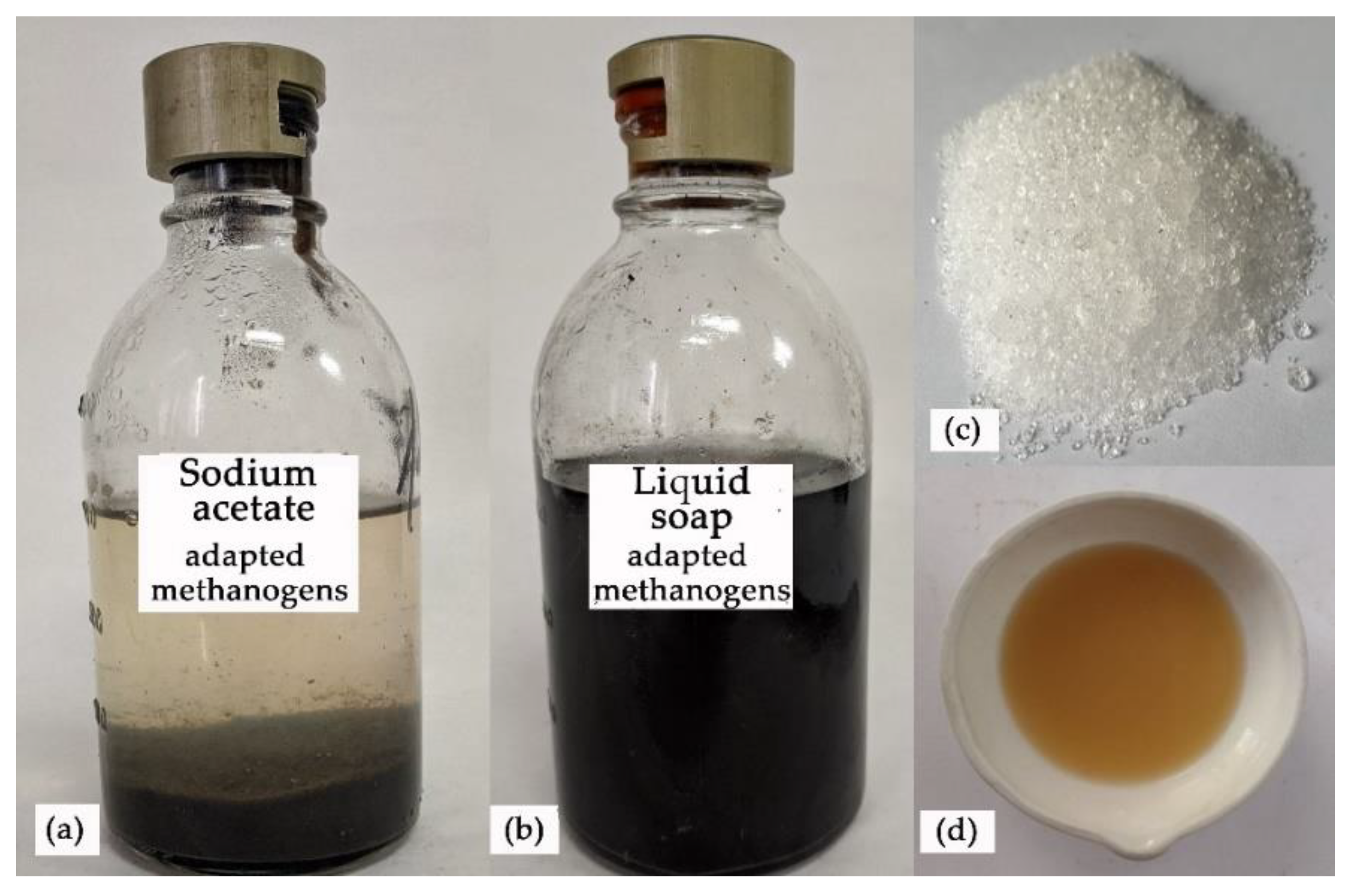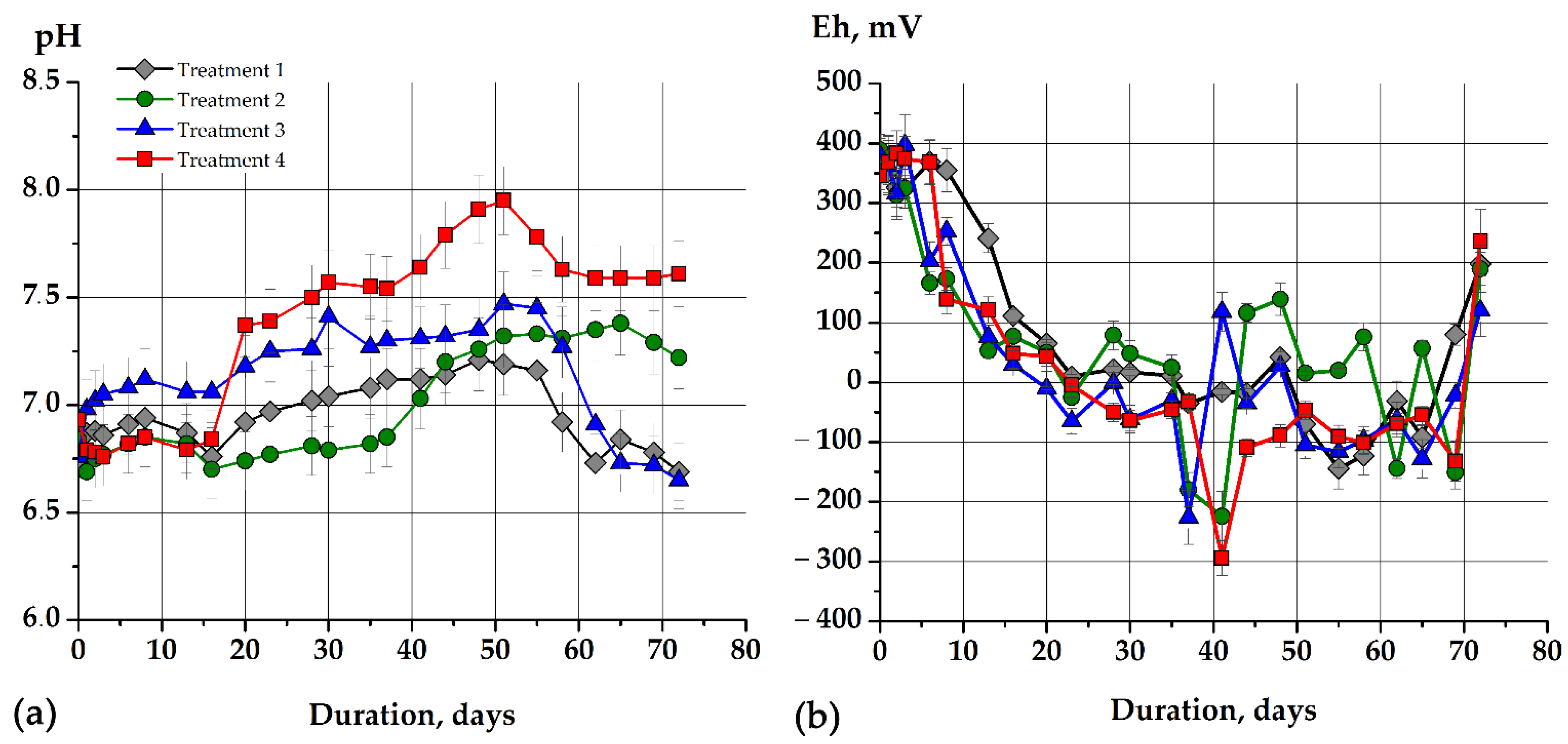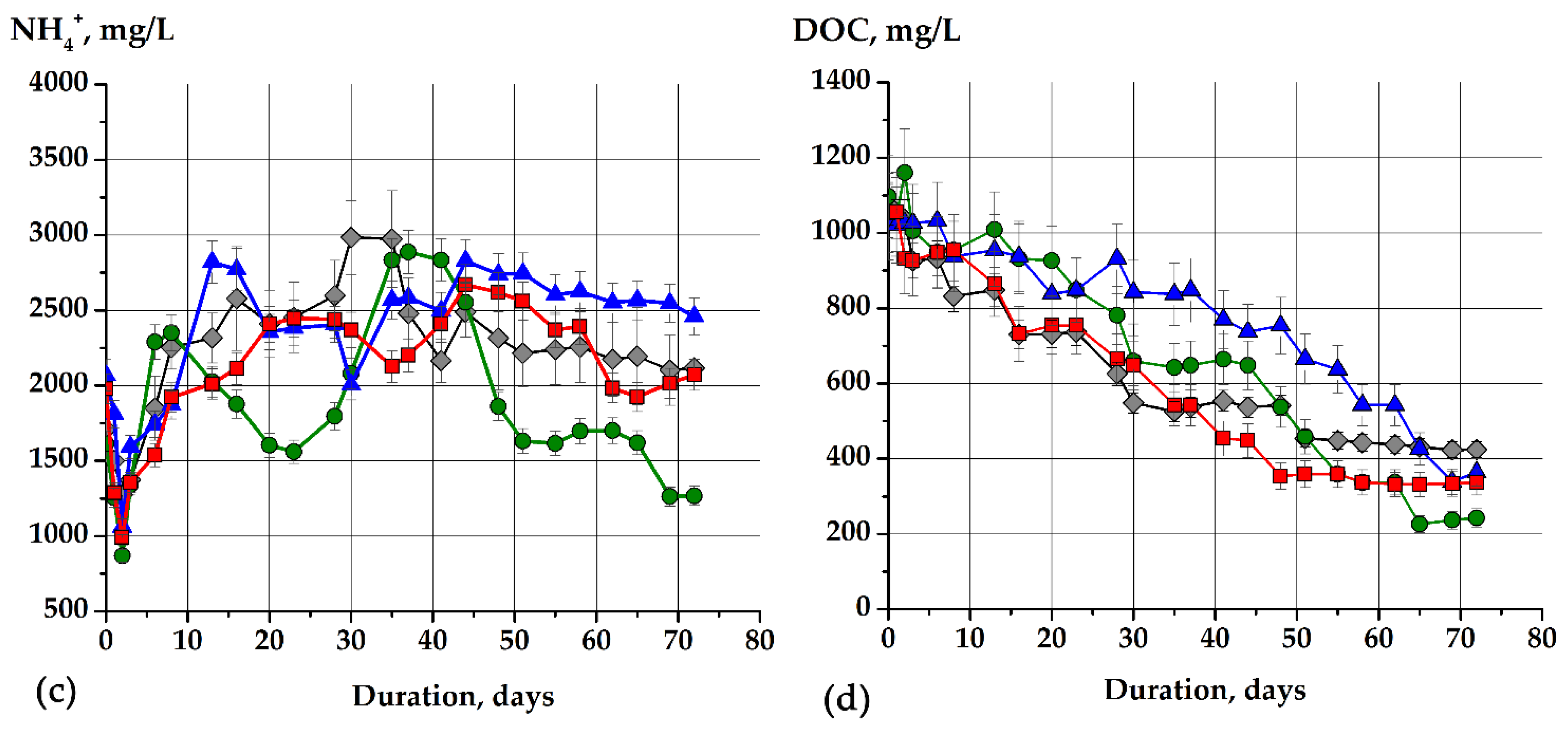Biodegradation of Synthetic Organic Compounds by Methanogenic Microbiome as an Alternative Approach for Wastewater Purification and Energy Production
Abstract
1. Introduction
- Hydrolysis of polymers [30]:
- 1.1.
- [C6H12O6]n → nC6H12O6;
- 1.2.
- Lipids → RCH2CH2COOH (LCFA) + glycerol
- 1.3.
- Proteins → amino acids
- Acetogenesis:
- Methanogenesis [33]:
- 3.1.
- Acetoclastic methanogenesis: CH3COOH = CH4↑ + CO2 (+120 mV);
- 3.2.
- Hydrogenotrophic methanogenesis: 4H2 + CO2 = CH4↑ +2H2O (+170 mV);
- 3.3.
- Hydrogenotrophic methanogenesis: CO2 + 8H+ + 8e− = CH4↑ +2H2O (–240 mV).
2. Materials and Methods
2.1. Design of the Experiment
2.2. Inoculum Preparation
2.3. Fermentation Process
2.4. Control of the Fermentation Parameters
2.5. Determination of the Effectiveness of the Degradation Process
- -
- the model soap stock and acetate degradation time (T, days)—defined as the duration of the process from the moment of the fermentation start until its termination (the termination of gas synthesis, etc.).
- -
- purification efficiency—calculated as the percentage of decrease in the concentration of DOC, %.
- -
- biomethane yield—calculated as the amount of CH4 (L) synthesized from 1 kg of organics counting also the dissolved organic carbon, L CH4/kg DOC.
- -
- carbon dioxide yield —calculated as the amount of CO2 (L) synthesized from 1 kg of organics counting also the dissolved organic carbon, L CO2/kg DOC.
3. Results
3.1. Dynamic of the Model Soapstock and Sodium Acetate Fermentation by Non-Adapted and Adapted Methanogenic Microorganisms
3.2. Dynamic of Sodium Acetate Stock and Model Soapstock Degradation by Methanogenic Microorganisms
3.3. Biogas Production from Sodium Acetate and Model Soapstock by Methanogenic Microorganisms
4. Discussion
5. Conclusions
Author Contributions
Funding
Informed Consent Statement
Data Availability Statement
Conflicts of Interest
References
- Shah, K.K.R.; Patel, G.B. Biodegradation of Soap Stock: As an Alternative Renewable Energy Resource and Reduce. In Innovations in Environmental Biotechnology; Springer: Berlin/Heidelberg, Germany, 2022; pp. 653–676. [Google Scholar] [CrossRef]
- Postigo, C.; Barceló, D. Synthetic Organic Compounds and Their Transformation Products in Groundwater: Occurrence, Fate and Mitigation. Sci. Total Environ. 2015, 503, 32–47. [Google Scholar] [CrossRef] [PubMed]
- Steber, J.; Berger, H. Biodegradability of Anionic Surfactants. In Biodegradability of Surfactants; Springer: Berlin/Heidelberg, Germany, 1995; pp. 134–182. [Google Scholar] [CrossRef]
- Wang, X.; Zhang, Y.; Li, Y.; Luo, Y.-L.; Pan, Y.-R.; Liu, J.; Butler, D. Alkaline Environments Benefit Microbial K-Strategists to Efficiently Utilize Protein Substrate and Promote Valorization of Protein Waste into Short-Chain Fatty Acids. Chem. Eng. J. 2021, 404, 127147. [Google Scholar] [CrossRef]
- Chirani, M.R.; Kowsari, E.; Teymourian, T.; Ramakrishna, S. Environmental Impact of Increased Soap Consumption during COVID-19 Pandemic: Biodegradable Soap Production and Sustainable Packaging. Sci. Total Environ. 2021, 796, 149013. [Google Scholar] [CrossRef]
- Bayanmunkh, M.; Bayasgalan, K.; Byambasuren, G.; Batchuluun, K.; Murneren, T. Synthetic Fatty Acid from Crude Oil of Tamsagbulag Petroleum Deposit (Mongolia). Mong. J. Chem. 2021, 22, 1–6. [Google Scholar] [CrossRef]
- Li, S.; Gao, L.; Wang, J.; Rong, G.; Cao, Y. Enhancement of Floatability of Low-Rank Coal Using Oxidized Paraffin Soap. RSC Adv. 2020, 10, 15098–15106. [Google Scholar] [CrossRef]
- Mohammad, A.; Singh, D.N.; Podlasek, A.; Osinski, P.; Koda, E. Leachate Characteristics: Potential Indicators for Monitoring Various Phases of Municipal Solid Waste Decomposition in a Bioreactor Landfill. J. Environ. Manag. 2022, 309, 114683. [Google Scholar] [CrossRef]
- Ofon, U.A.; Ndubuisi-Nnaji, U.U.; Shaibu, S.E.; Fatunla, O.K.; Offiong, N.-A.O. Recycling Anaerobic Digestate Enhances the Co-Digestion Potential of Agro-Industrial Residues: Influence of Different Digestates as Sources of Microbial Inoculum. Environ. Technol. 2021, 1–12. [Google Scholar] [CrossRef]
- Achaw, O.-W.; Danso-Boateng, E. Soaps and Detergents. In Chemical and Process Industries; Springer: Berlin/Heidelberg, Germany, 2021; pp. 1–37. [Google Scholar] [CrossRef]
- Mousavi, S.A.; Khodadoost, F. Effects of Detergents on Natural Ecosystems and Wastewater Treatment Processes: A Review. Environ. Sci. Pollut. Res. 2019, 26, 26439–26448. [Google Scholar] [CrossRef] [PubMed]
- Casillas-Vargas, G.; Ocasio-Malavé, C.; Medina, S.; Morales-Guzmán, C.; Del Valle, R.G.; Carballeira, N.M.; Sanabria-Ríos, D.J. Antibacterial Fatty Acids: An Update of Possible Mechanisms of Action and Implications in the Development of the next-Generation of Antibacterial Agents. Prog. Lipid Res. 2021, 82, 101093. [Google Scholar] [CrossRef]
- Ababouch, L.; Chaibi, A.; Busta, F.F. Inhibition of Bacterial Spore Growth by Fatty Acids and Their Sodium Salts. J. Food Prot. 1992, 55, 980–984. [Google Scholar] [CrossRef]
- Fay, J.; Farias, R. The Inhibitory Action of Fatty Acids on the Growth of Escherichia coli. Microbiology 1975, 91, 233–240. [Google Scholar] [CrossRef]
- Demirbas, A.; Edris, G.; Alalayah, W.M. Sludge Production from Municipal Wastewater Treatment in Sewage Treatment Plant. Energy Sources Part Recovery Util. Environ. Eff. 2017, 39, 999–1006. [Google Scholar] [CrossRef]
- Peng, W.; Chang, L.; Li, P.; Han, G.; Huang, Y.; Cao, Y. An Overview on the Surfactants Used in Ion Flotation. J. Mol. Liq. 2019, 286, 110955. [Google Scholar] [CrossRef]
- Bartels, C.R.; Wilf, M.; Andes, K.; Iong, J. Design Considerations for Wastewater Treatment by Reverse Osmosis. Water Sci. Technol. 2005, 51, 473–482. [Google Scholar] [CrossRef]
- Bóna, Á.; Bakonyi, P.; Galambos, I.; Bélafi-Bakó, K.; Nemestóthy, N. Separation of Volatile Fatty Acids from Model Anaerobic Effluents Using Various Membrane Technologies. Membranes 2020, 10, 252. [Google Scholar] [CrossRef]
- Martínez-Huitle, C.A.; Panizza, M. Electrochemical Oxidation of Organic Pollutants for Wastewater Treatment. Curr. Opin. Electrochem. 2018, 11, 62–71. [Google Scholar] [CrossRef]
- Zhang, M.; Dong, H.; Zhao, L.; Wang, D.; Meng, D. A Review on Fenton Process for Organic Wastewater Treatment Based on Optimization Perspective. Sci. Total Environ. 2019, 670, 110–121. [Google Scholar] [CrossRef]
- Xiao, J.; Xie, Y.; Cao, H. Organic Pollutants Removal in Wastewater by Heterogeneous Photocatalytic Ozonation. Chemosphere 2015, 121, 1–17. [Google Scholar] [CrossRef]
- Kansara, N.; Bhati, L.; Narang, M.; Vaishnavi, R. Wastewater Treatment by Ion Exchange Method: A Review of Past and Recent Researches. Environ. Sci. Indian J. 2016, 12, 143–150. [Google Scholar]
- Reyhanitash, E.; Kersten, S.R.; Schuur, B. Recovery of Volatile Fatty Acids from Fermented Wastewater by Adsorption. ACS Sustain. Chem. Eng. 2017, 5, 9176–9184. [Google Scholar] [CrossRef]
- Singh, P.; Sharda, S.; Cauhan, S.S. Domestic Waste Water Treatment by Fly and Wood Ash along with Additive Materials. Int. J. Civ. Eng. Technol. 2016, 7, 67–75. Available online: http://www.iaeme.com/IJCIET/index.asp (accessed on 5 May 2022).
- Gude, V.G. Wastewater Treatment in Microbial Fuel Cells—An Overview. J. Clean. Prod. 2016, 122, 287–307. [Google Scholar] [CrossRef]
- Maier, R.M.; Gentry, T.J. Microorganisms and Organic Pollutants. In Environmental Microbiology; Elsevier: Amsterdam, The Netherlands, 2015; pp. 377–413. [Google Scholar] [CrossRef]
- Anijiofor, S.C.; Jamil, N.A.M.; Jabbar, S.; Sakyat, S.; Gomes, C. Aerobic and Anaerobic Sewage Biodegradable Processes: The Gap Analysis. Int. J. Res. Environ. Sci. 2017, 3, 9–19. [Google Scholar] [CrossRef]
- Kong, Z.; Li, L.; Xue, Y.; Yang, M.; Li, Y.-Y. Challenges and Prospects for the Anaerobic Treatment of Chemical-Industrial Organic Wastewater: A Review. J. Clean. Prod. 2019, 231, 913–927. [Google Scholar] [CrossRef]
- Chávez, A.; Gimeno, O.; Rey, A.; Pliego, G.; Oropesa, A.; Álvarez, P.; Beltrán, F. Treatment of Highly Polluted Industrial Wastewater by Means of Sequential Aerobic Biological Oxidation-Ozone Based AOPs. Chem. Eng. J. 2019, 361, 89–98. [Google Scholar] [CrossRef]
- Pereira, M.A. Anaerobic Biodegradation of Long Chain Fatty Acids Biomethanisation of Biomass-Associated LCFA as a Challenge for the Anaerobic Treatment of Effluents with High Lipid/LCFA Content. 2003. Available online: https://hdl.handle.net/1822/4650 (accessed on 28 June 2022).
- De Amorim, E.L.C.; Barros, A.R.; Damianovic, M.H.R.Z.; Silva, L.D. Anaerobic fluidized bed reactor with expanded clay as support for hydrogen production through dark fermentation of glucose. Int. J. Hydrog. Energy 2009, 34, 783–790. [Google Scholar] [CrossRef]
- Sousa, D.Z.; Balk, M.; Alves, M.; Schink, B.; McInerney, M.J.; Smidt, H.; Plugge, C.M.; Stams, A.J. Degradation of Long-Chain Fatty Acids by Sulfate-Reducing and Methanogenic Communities. In Handbook of Hydrocarbon and Lipid Microbiology; Timmis, K.N., Ed.; Springer: Berlin/Heidelberg, Germany, 2010. [Google Scholar] [CrossRef]
- Thauer, R.K. Biochemistry of methanogenesis: A tribute to Marjory Stephenson: 1998 Marjory Stephenson prize lecture. Microbiology 1998, 144, 2377–2406. [Google Scholar] [CrossRef]
- Hovorukha, V.; Havryliuk, O.; Bida, I.; Danko, Y.P.; Shabliy, O.; Gladka, G.; Yastremska, L.; Tashyrev, O. Two-stage degradation of solid organic waste and liquid filtrate. Biotechnol. Acta 2021, 14, 70–79. [Google Scholar] [CrossRef]
- Gésan-Guiziou, G. Removal of Bacteria, Spores and Somatic Cells from Milk by Centrifugation and Microfiltration Techniques. In Improving the Safety and Quality of Milk; Elsevier: Amsterdam, The Netherlands, 2010; pp. 349–372. [Google Scholar] [CrossRef]
- Havryliuk, O.; Hovorukha, V.; Savitsky, O.; Trilis, V.; Kalinichenko, A.; Dołhańczuk-Śródka, A.; Janecki, D.; Tashyrev, O. Anaerobic Degradation of Environmentally Hazardous Aquatic Plant Pistia stratiotes and Soluble Cu(II) Detoxification by Methanogenic Granular Microbial Preparation. Energies 2021, 14, 3849. [Google Scholar] [CrossRef]
- Acree, W.E. Basic Gas Chromatography (McNair, Harold M.; Miller, James M.). J. Chem. Educ. 1998, 75, 1094. [Google Scholar] [CrossRef][Green Version]
- Suslova, O.; Govorukha, V.; Brovarskaya, O.; Matveeva, N.; Tashyreva, H.; Tashyrev, O. Method for Determining Organic Compound Concentration in Biological Systems by Permanganate Redox Titration. Int. J. Bioautom. 2014, 18, 45–52. Available online: http://www.biomed.bas.bg/bioautomation/2014/vol_18.1/files/18.1_05.pd (accessed on 12 June 2022).
- Qiu, X.; Liu, G.-P.; Zhu, Y.-Q. Determination of Water-Soluble Ammonium Ion in Soil by Spectrophotometry. Analyst 1987, 112, 909–911. [Google Scholar] [CrossRef]
- Ziels, R.M.; Karlsson, A.; Beck, D.A.; Ejlertsson, J.; Yekta, S.S.; Bjorn, A.; Stensel, H.D.; Svensson, B.H. Microbial Community Adaptation Influences Long-Chain Fatty Acid Conversion during Anaerobic Codigestion of Fats, Oils, and Grease with Municipal Sludge. Water Res. 2016, 103, 372–382. [Google Scholar] [CrossRef]
- Kougias, P.G.; Treu, L.; Campanaro, S.; Zhu, X.; Angelidaki, I. Dynamic Functional Characterization and Phylogenetic Changes Due to Long Chain Fatty Acids Pulses in Biogas Reactors. Sci. Rep. 2016, 6, 28810. [Google Scholar] [CrossRef]
- Coiffard, L.; Couteau, C. Soap and Syndets: Differences and Analogies, Sources of Great Confusion. Eur. Rev. Med. Pharmacol. Sci. 2020, 24, 11432–11439. [Google Scholar] [CrossRef]
- Nwinyi, O.C.; Umane, P.O. Degradation Potentials of Tropical Soil Bacteria on Detergents. IOP Publ. 2021, 665, 012071. [Google Scholar] [CrossRef]
- Osadebe, A.U.; Onyiliogwu, C.A.; Okpokwasili, G.C. Biodegradation of Anionic Surfactants from Oil Field Detergents in Aquatic Systems. Univers. J. Microbiol. 2018, 6, 7–14. [Google Scholar] [CrossRef]
- Ojo, O.A.; Oso, B.A. Biodegradation of Synthetic Detergents in Wastewater. Afr. J. Biotechnol. 2009, 8, 1090–1109. Available online: http://www.academicjournals.org/AJB (accessed on 10 May 2022).
- Szymanowska-Powałowska, D.; Kubiak, P.; Lewicki, A. The Methane Fermentation Medium as an Attractive Source of Bacteria from Genus Clostridium Capable of Converting Glycerol into 1, 3-Propylene Glycol. Biotechnol. J. Biotechnol. Comput. Biol. Bionanotechnol. 2012, 93, 68–77. [Google Scholar] [CrossRef]
- Thayer, L.A. Bacterial Genesis of Hydrocarbons from Fatty Acids. AAPG Bull. 1931, 15, 441–453. [Google Scholar] [CrossRef]
- Tarvin, D.; Buswell, A. The Methane Fermentation of Organic Acids and Carbohydrates. J. Am. Chem. Soc. 1934, 56, 1751–1755. [Google Scholar] [CrossRef]
- Pagliano, G.; Ventorino, V.; Panico, A.; Pepe, O. Integrated Systems for Biopolymers and Bioenergy Production from Organic Waste and By-Products: A Review of Microbial Processes. Biotechnol. Biofuels 2017, 10, 113. [Google Scholar] [CrossRef]
- Borowski, S.; Cieciura-Włoch, W. Enzymatic Pretreatment of Byproducts from Soapstock Splitting and Glycerol Processing for Improvement of Biogas Production. Molecules 2021, 26, 6782. [Google Scholar] [CrossRef]
- Cherif, S.; Aloui, F.; Carrière, F.; Sayadi, S. Lipase Pre-Hydrolysis Enhance Anaerobic Biodigestion of Soap Stock from An Oil Refining Industry. J. Oleo Sci. 2014, 63, 109–114. [Google Scholar] [CrossRef]
- Yu, N.; Xing, D.; Li, W.; Yang, Y.; Li, Z.; Li, Y.; Ren, N. Electricity and Methane Production from Soybean Edible Oil Refinery Wastewater Using Microbial Electrochemical Systems. Int. J. Hydrog. Energy 2017, 42, 96–102. [Google Scholar] [CrossRef]
- Thomas, M.; Kozik, V.; Barbusiński, K.; Sochanik, A.; Jampilek, J.; Bąk, A. Potassium Ferrate (VI) as the Multifunctional Agent in the Treatment of Landfill Leachate. Materials 2020, 13, 5017. [Google Scholar] [CrossRef]
- Tałałaj, I.A.; Biedka, P.; Bartkowska, I. Treatment of Landfill Leachates with Biological Pretreatments and Reverse Osmosis. Environ. Chem. Lett. 2019, 17, 1177–1193. [Google Scholar] [CrossRef]




| Treatment | Inoculum of Methanogens | Substrate | Initial DOC, mg/L |
|---|---|---|---|
| Control 1 | - | Soap | 1000 |
| Control 2 | - | Sodium acetate | 1000 |
| 1 | Non-adapted | Soap | 1000 |
| 2 | Adapted | Soap | 1000 |
| 3 | Non-adapted | Sodium acetate | 1000 |
| 4 | Adapted | Sodium acetate | 1000 |
Publisher’s Note: MDPI stays neutral with regard to jurisdictional claims in published maps and institutional affiliations. |
© 2022 by the authors. Licensee MDPI, Basel, Switzerland. This article is an open access article distributed under the terms and conditions of the Creative Commons Attribution (CC BY) license (https://creativecommons.org/licenses/by/4.0/).
Share and Cite
Bida, I.; Shabliy, O.; Havryliuk, O.; Hovorukha, V.; Gladka, G.; Yastremska, L.; Kalinichenko, A.; Janecki, D.; Tashyrev, O. Biodegradation of Synthetic Organic Compounds by Methanogenic Microbiome as an Alternative Approach for Wastewater Purification and Energy Production. Energies 2022, 15, 6556. https://doi.org/10.3390/en15186556
Bida I, Shabliy O, Havryliuk O, Hovorukha V, Gladka G, Yastremska L, Kalinichenko A, Janecki D, Tashyrev O. Biodegradation of Synthetic Organic Compounds by Methanogenic Microbiome as an Alternative Approach for Wastewater Purification and Energy Production. Energies. 2022; 15(18):6556. https://doi.org/10.3390/en15186556
Chicago/Turabian StyleBida, Iryna, Oleksandra Shabliy, Olesia Havryliuk, Vira Hovorukha, Galina Gladka, Larysa Yastremska, Antonina Kalinichenko, Daniel Janecki, and Oleksandr Tashyrev. 2022. "Biodegradation of Synthetic Organic Compounds by Methanogenic Microbiome as an Alternative Approach for Wastewater Purification and Energy Production" Energies 15, no. 18: 6556. https://doi.org/10.3390/en15186556
APA StyleBida, I., Shabliy, O., Havryliuk, O., Hovorukha, V., Gladka, G., Yastremska, L., Kalinichenko, A., Janecki, D., & Tashyrev, O. (2022). Biodegradation of Synthetic Organic Compounds by Methanogenic Microbiome as an Alternative Approach for Wastewater Purification and Energy Production. Energies, 15(18), 6556. https://doi.org/10.3390/en15186556












